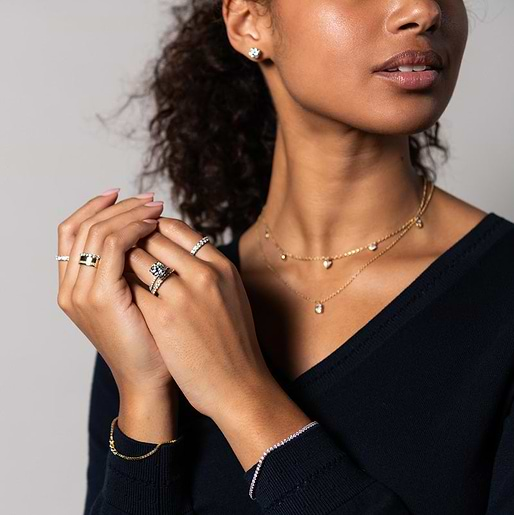Price Comparison: Is White Gold More Expensive Than Yellow Gold

Being on the fence about whether you should go with white gold or yellow gold is a good problem to have. They are both high quality metals that complement engagement rings, wedding bands, and a slew of fine jewelry options. Because of that, your choice will likely come down to price (and in some cases durability).
By the end of this blog, you should have a better understanding of how both are priced and which is worth emptying your bank account for.
What are Yellow Gold and White Gold?
When you understand the makeup of a metal, you’ll likely question the why behind the price tag a little less. Whether it’s on the higher end or lower end of the spectrum, there’s a reason metals like yellow gold and white gold hold a certain market value. That reason is below:
What is Yellow Gold?
Yellow gold is a mix of pure gold and other metals, or what’s more commonly known as alloy. Alloy can consist of copper, zinc, silver, nickel, or palladium. Because pure gold is a “soft” metal that’s prone to damage, the support of the metals from alloy makes it more realistic for everyday wear. With that said, the composition of pure gold and alloy can vary. Here’s what that looks like:
-
18K Yellow Gold: 75% Pure Gold, 12% Copper, 12.5% Silver or Zinc
-
14K Yellow Gold: 58.3% Pure Gold, 29% Copper, 12.7% Silver or Zinc
-
10K Yellow Gold: 41.7% Pure Gold, 52% Copper, 6.3% Silver or Zinc
What is White Gold?
Much like yellow gold, white gold is a mix of pure gold and alloy. But in this case, little or no copper is used to create a lighter appearance. You’ll likely need “white” metals like palladium, nickel, silver, or zinc to create its look and enhance its strength. That composition can look like this:
-
18K White Gold: 75% Pure Gold, 25% White Metals
-
14K White Gold: 58.3% Pure Gold, 41.7% White Metals
-
10K White Gold: 41.7% Pure Gold, 58.3% White Metals
It’s also important to note that white gold is often plated with rhodium, a metal that enhances the shine and bright white color that many love.
As you can see, the main difference between the two is how much and the kind of alloy being used, which creates the color difference. How does this affect pricing? Let’s get you the answer to your burning question.

The Cost of White Gold vs Yellow Gold
With gold, you’ll generally spend more when there is less alloy and more “purity.” But as far as white gold and yellow gold, you find that pricing is generally the same. Where cost difference comes in circles back to the composition. Alloy contents are important because that’s where the metals get the durability you need to wear them day in and day out.
White gold tends to fall short as far as wear because of the plating that gives you that silver shine. The more you wear it, the higher the possibility the plating is wearing off. And that’s why care or maintenance is the main factor that affects the cost of white gold vs yellow gold. This is where pros and cons should come into consideration.
Advantages and Disadvantages of White Gold and Yellow Gold
Whether or not something is worth the price can be summed up by what matters most to you. No matter what piece of white gold or yellow gold jewelry you choose, there are three key things you should consider. What are your personal style preferences? What level of durability does your lifestyle require? How much are you willing to spend to maintain it? To get you closer to the answer to those questions, here is a breakdown of the pros and cons of white gold and yellow gold.
White Gold Pros
-
Affordable compared to platinum
-
More scratch resistant compared to yellow gold
-
Modern appeal
White Gold Cons
-
Higher maintenance due to rhodium wear
-
May cause skin reactions in some people
Yellow Gold Pros
-
Better color retention
-
Easier maintenance
-
Less likely to cause skin reactions
Yellow Gold Cons
-
More prone to scratches
-
Requires some polishing

Which One Is Right for You?
With there being little difference in the price of white gold vs yellow gold, your personal preferences are ultimately the deciding factor on which is worth it. The main thing to keep in mind is what level of maintenance you’re willing to put into your choice. If you don’t have a good warranty, repairing scratching, dents, or replating can be costly.
Ultimately, it’s important to choose a jeweler who understands the value of your investment and supports you with the upkeep of your jewelry. When you choose white gold or yellow gold jewelry from Plum Diamonds, you’ll receive a free lifetime warranty to maintain the beauty and strength of your purchase. That ranges from polishing, replating, and professional cleaning or what we like to call “spa days” for your jewelry.
In the end, with the right maintenance support, you can’t go wrong with either choice.


